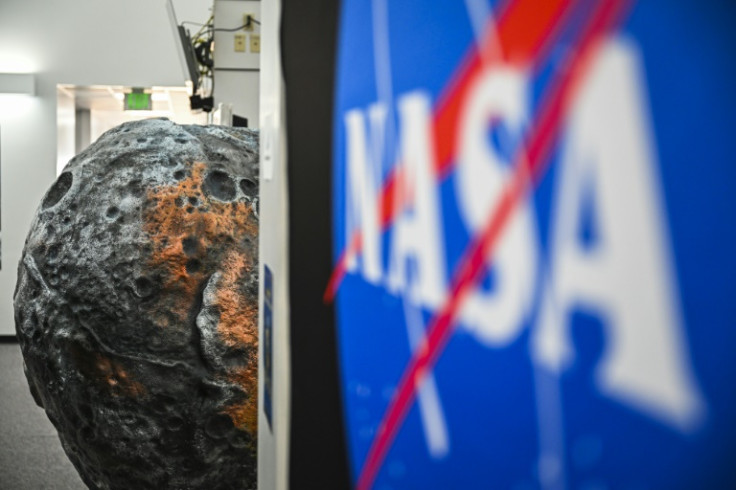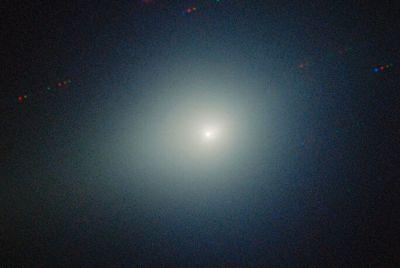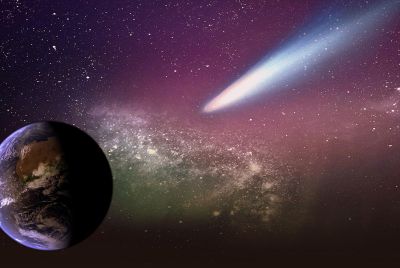NASA on Alert as 3I/ATLAS Changes Course: Could This Comet Really Be Headed for Earth?
Could this interstellar visitor truly pose a danger to our home planet?

For only the third time in history, an object from beyond our own solar system is making an unexpected, high-speed pass through our cosmic neighbourhood. This time, the visitor is Comet 3I/ATLAS, and its strange, new trajectory has put space agencies around the world, particularly NASA, on high alert.
With its peculiar size, speed, and behaviour, the burning question remains: could this interstellar visitor truly pose a danger to our home planet?
A Harvard Physicist's Warning of an 'Intercept Earth' Trajectory
On the social media platform X, physicist Dr John Brandenburg cautioned that the new interstellar object might be altering its course toward our planet. He addressed his followers as 'Friends', going on to state that the 'full effect of the observed changes in the 3I ATLAS jets may be to change its orbit to Intercept Earth'.
On 1 July, experts from the Asteroid Terrestrial-impact Last Alert System (ATLAS) detected a body rapidly moving through our star system on a route that will see it depart. It was quickly identified as an interstellar arrival, making it just the third object we have encountered following 1I/' Oumuamua and 2I/Borisov.
Friends: The full effect of the observed changes in the 3I ATLAS jets may be to change its orbit to Intercept Earth. 3I is moving in retrograde to Earth' orbit so Major Orbit Changes May Manifest Themselves Rapidly with closure rates of ~ 100km/sec. CHECK THIS TRAJECTORY ESTIMATE pic.twitter.com/X0CtjpXzMh
— Dr. John Brandenburg (@PhdBrandenburg) October 27, 2025
Continuing his X post, Dr Brandenburg pointed out that 3I's retrograde motion relative to Earth's orbit means significant alterations to its path could appear quickly, with closing speeds of about 100 kilometres per second.
Evidence of a Possible 'Technological' Shift in Course
Dr Brandenburg shared a high-resolution image he labelled a 'trajectory estimate' for Comet 3I/ATLAS, showing how changes in propulsive force could alter its trajectory. The image shows that the object's original orbit doesn't align with two revised trajectories — one from a braking force and the other from an accelerating force, both resulting in an orbit closer to the Sun.
Dr Brandenburg believes that this second alteration could put the object on a possible collision path with Earth. This potential for trajectory change is coupled with new insights into the comet's behaviour.
New observations from the Nordic Optical Telescope, located in the Canary Islands, Spain, now suggest that 3I/ATLAS's unusual sun-facing, or anti-solar, tail has shifted direction and is now primarily a tail that points away from the Sun.
Unusual Features: The Mystery of the 'Anti-Tail'
Space experts have been monitoring 3I/ATLAS since 1 July, discovering several peculiar characteristics of the comet, which some think could be a 10-billion-year-old relic from the universe's earlier history. One strange, and seldom observed, characteristic of the object is an 'anti-tail', which was visible throughout July and August.
When comets near the Sun, their volatile ices sublimate (changing straight from solid to gas), which releases gas and dust particles from the surface.
As the comet moves through space, the solar wind and radiation pressure push these materials in the opposite direction from the Sun, forming the unique halo, or coma, in its wake. At least, this is the typical behaviour observed in most comets.
However, certain comets can also display an 'anti-tail' which seems to point towards the Sun, alongside their normal dust and ion tails. Usually, this is merely an optical trick caused by our viewing position, but on rare occasions, it can be a genuine anti-tail.
'Occasionally, a comet can be seen also showing a 'third' tail apparently pointing towards the Sun. This is known as an 'anti-tail' and is an optical illusion', the European Space Agency (ESA) clarifies about this phenomenon.
'The tail is really pointing directly away from the Sun, but because of the Earth's relative location in space, we see the wide tail, fanning out behind the comet and appearing to be on either side of the central region containing the nucleus.'
🚨 The Sunward Glow of 3I/ATLAS is 10x Longer Than It is Wide 🚨
— Skywatch Signal (@UAPWatchers) September 12, 2025
Avi Loeb & Eric Keto’s new Hubble analysis just revealed something unprecedented about our latest interstellar visitor.
Buckle up this one changes the game. 🧵👇 pic.twitter.com/2qsErg0LAF
A research paper by Harvard astronomers Avi Loeb and Eric Keto explains that 'Observations of interstellar comet 3I/ATLAS at 3.8 au show an elongated coma similar to a cometary tail but pointing in the direction of the Sun', before noting that 'this type of anti-tail, not a result of perspective, may not have been previously observed'.
However, Jason Wright, a professor of astronomy and astrophysics at Penn State, noted that these anti-tails have been observed previously, with observations dating back to at least 1974 with Comet Kohoutek.
Michael Busch, an NSF Astronomy and Astrophysics Postdoctoral Fellow, clarified on BlueSky, 'With a rotating comet nucleus, ejecta from a spot can come off with heliocentric velocity that puts it either in front of or behind the nucleus - it does not matter which side it starts from'.
With a rotating comet nucleus; ejecta from a spot can come off with heliocentric velocity that puts it either in front of or behind the nucleus - it does not matter which side it starts from.
— Michael Busch (@michael-w-busch.bsky.social) 2025-09-28T21:54:17.421Z
He added, 'Small dust and ejected gas gets pushed out by radiation pressure and solar wind. But larger pieces of ejecta spread out along the orbit; both in front of and behind the nucleus. For solar system comets, this eventually gives a meteoroid stream around the entire orbit'.
Why 3I/ATLAS's Initial Activity is Unique
Although anti-tails aren't unprecedented, they remain uncommon and quite fascinating. By tracking 3I/ATLAS as it nears the Sun, we can learn a great deal about the object itself and the place it originated from.
The writers of a recent, yet to be peer-reviewed study explained that 'It is statistically unlikely that 3I has approached any star more closely than it will approach the Sun in 2025, at least since the (presumed) ejection from its parent protoplanetary disk'.
They concluded, 'Therefore, pre-perihelion observations present an opportunity to study the rise of activity on an object that has been held at interstellar temperatures (≲10 K) possibly for billions of years'. The team noticed that the anti-tail transitioned into a proper tail during September.
The team explained that the comet's shape shifted from a sun-facing dust fan in early July 2025 to a primarily dust-tailed configuration facing away from the Sun later on. They also noted that separate spectroscopic measurements indicate that carbon dioxide is the main driver of the object's activity.
'We attribute the delayed emergence of the tail to the large size (effective radius 100 µm) and slow ejection (5 m s-1) of the optically dominant dust particles, and their consequently sluggish response to solar radiation pressure', the team noted.
Loeb's Theory: A Technological Mechanism Behind the Shift
In another study, Harvard astronomers Avi Loeb and Eric Keto put forward a different explanation for the slow transformation from an anti-tail to a normal tail. In a related blog post, Loeb explains that 'As 3I/ATLAS approaches the Sun, the exponential temperature dependence of the sublimation rate causes a continuous increase in the production rate of ice fragments and a sharp decline in their residence time in the outflow'.
'The combined effects produce a peak in total scattering cross-section due to H2O ice grains at a distance of 3 to 4 au from the Sun. At closer heliocentric distances, the scattering becomes dominated by longer-lived refractory dust particles and larger volatile grains with survival times long enough to form a tail that stretches away from the Sun.'
Loeb points out that from July to October, the comet lost about 2 million tons of material, which is roughly $0.00005$ per cent of the total mass of $33$ billion tons calculated by his team. Since Loeb has previously hinted at extraterrestrial involvement in natural phenomena, he proposes that the shift from an anti-tail to a normal tail might signal that the object is technological in nature.
'My colleague, Adam Hibberd, pointed out that if the object is an alien spacecraft slowing down, and the anti-tail is braking thrust, then this change from anti-tail to tail would be entirely expected near perihelion', he wrote.
'In that case, the transition would constitute a technosignature in the form of an unexpected phenomenon indicative of controlled manoeuvring, possibly with the intention of achieving a bound heliocentric orbit between Mars's and Jupiter's orbits.'
Testing the 'Alien Mothership' Scenario
While nearly every other astronomer, including SETI and NASA, remains convinced the object is natural due to its comet-like actions, we'll soon have the chance to test this 'alien mothership' theory.
The object will return to the view of our instruments in December. If it proceeds along its outbound route from the Solar System, the alien craft suggestion will seem quite absurd. We hope to capture many more observations of the body before it leaves, so that we can gather more information about this ancient and well-travelled comet.
© Copyright IBTimes 2025. All rights reserved.






















